This was published 1 year ago
She’s ‘Asia’s sweetheart’, but have you heard of Aussie-born celebrity Anne Curtis?
In the Philippines, Anne Curtis is the mega-celebrity Australia doesn’t know it has: mobbed in the streets of Manila and more popular than Taylor Swift. For the film and TV star, it’s a long way from her upbringing in rural Victoria.
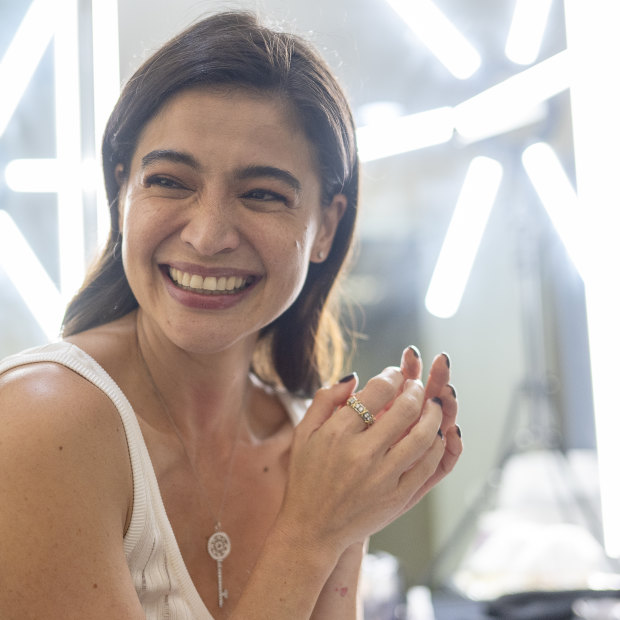
Anne Curtis in her dressing room after a broadcast of the Philippines’ three-hour It’s Showtime variety program. The country’s Tatler magazine has called her “the definition of a superstar today”.Credit: Dave Tacon
In February, Anne Curtis will celebrate her 39th birthday by attending the Taylor Swift concert at the Melbourne Cricket Ground. Probably, no one will recognise her. No one will ask her for a selfie, or want to touch her or cry with the excitement of meeting her in person.
She pronounces herself “a big Swiftie”. Attending the concert without being recognised will be “nice”, she says. “I love being able to live normally when I’m in Australia.” It is also extraordinary, because Curtis is one of the world’s most famous Australian celebrities. Curtis represents a paradox: hugely famous yet virtually unheard of in the country of her birth.
“When I am in Melbourne, I can go to Coles and do my own grocery shopping,” she says. “I can walk on the beach. I love it. I really love it.”
At home in the Philippines, she can’t show her face in public without being mobbed. She is a television star, a film actress with 32 movies to her name, a social media influencer and, sort of, a singer – about which, more later. She is often described as Asia’s sweetheart.
It is perhaps a measure of the degree to which Australia remains divorced from its geography that Anne Curtis can be at once so famous in the countries of our region, the Philippines in particular, yet most of her countrymen have never heard of her. She has 20 million followers on Instagram and 18 million on Facebook. For comparison, Miranda Kerr has 15 million and 8.4 million respectively.
Filipinos are among the most widely dispersed peoples in the world. So it is that Anne Curtis, the daughter of an Australian lawyer and a Filipino mother, born in Wangaratta in Victoria and raised in nearby Yarrawonga, was the top Instagram influencer in the United Arab Emirates in 2019, according to the metrics website Hype Auditor.
She posts almost daily on social media: promotions for the brands she endorses, and polished pictures and videos of her daily life. There is Curtis behaving like a “manic pixie” at Paris Fashion Week; Curtis completing the Tokyo marathon (through which she raised money for UNICEF); Curtis with her husband, restaurateur turned food documentary maker Erwan Heussaff. The full-length video of the couple’s 2017 wedding, for which an A-list of Filipino celebrities travelled to Queenstown, New Zealand, has had 14 million views on YouTube.
And, in the corners of all this, there are glimpses of Australia: Heussaff in a Father’s Day video with their then two-year-old daughter, Dahlia, on his shoulders as he walks towards Flinders Street Station in Melbourne. Older pictures of a heavily pregnant Anne in front of the Brighton bathing boxes. She knows Australia, but Australia doesn’t know her.
It is hard to overstate the extent of Curtis’s celebrity among the 118 million people of the Philippines. Her picture is everywhere in the streets advertising cosmetics (she has her own brand), household electrical goods, multivitamins, juices and, most prominently, Chickenjoy – the fried offering of the Jollibee fast food chain, which is the locally grown answer to McDonald’s.
In September, she featured on the cover of Tatler Philippines in an issue devoted to Asia’s most stylish. “It’s Anne Curtis. ’Nuff said” was the cover line; she needed no introduction, according to the editor-in-chief, Anton San Diego, who wrote that Curtis “has become the benchmark and the definition of a superstar today”.
On the cover, she wore a Dior black belt buckled as a collar around her neck and a Schiaparelli earring dangling from her eye socket like a monocle. Yet she insisted she was a “simple surfer chick” at heart, happy in denim, tees and sneakers.
Over two weeks in the Philippines, I asked taxi drivers, shop assistants and people in the street who was the most famous: Anne Curtis or Taylor Swift? The answer came back without hesitation: always Curtis. The secret to her appeal? “She is beautiful on the inside and on the outside,” said one. “She is so down to earth. You feel like you know her,” said another. Make-up
artist Robbie Piñera, who has had Curtis as his full-time occupation since 2008, sums it up when he says, “She is aspirational but approachable.” She is a fashionista who has retained the common touch.
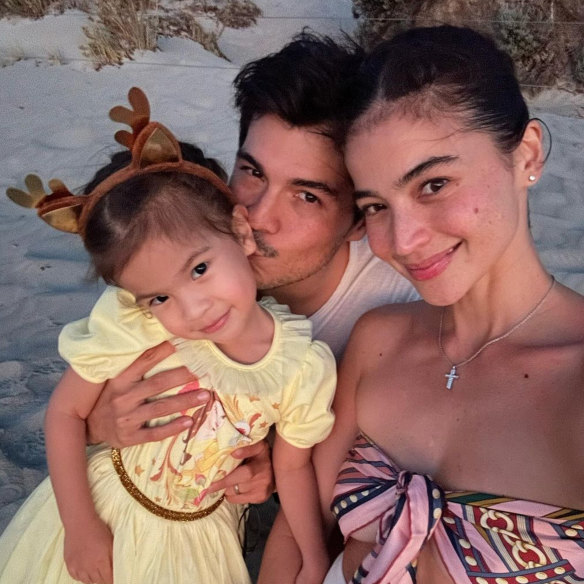
Curtis with her husband, Erwan Heussaff , and their daughter, Dahlia, in Fremantle in January.Credit: @annecurtissmith/Instagram
Her singing might be her only duff note, although she has released studio albums and given sell-out concerts. Even her fans acknowledge her voice is not her strength, but admire her for having a go. She told a critical fan on social media some years ago that she is tone-deaf and, listening to her, it is easy to believe. She has worked hard trying to improve, and she is sensitive about it. Yet, she sings – often. She sings her heart out.
Curtis tells me her life is an open book. It is true that her living room – white couch, floaty curtains, buttery light – features on Instagram. It is true that her followers have seen her unpacking and apparently asleep on an Emma mattress, a brand she endorses. It is true they have seen pictures of her breastfeeding Dahlia, as part of her advocacy for UNICEF and its campaign for the importance of the first 1000 days of a child’s life.
In one of two interviews she granted for this story, and during a visit to the set of It’s Showtime – the daytime variety show that is one of the foundations for her fame – she was lively, generous and sweet, quick to laugh and apparently unaffected.
That said, there were limits. Questions about her wealth were “too private”. (In 2017, Filipino celebrity magazine Taddlr estimated her net worth at $US10 million.) We weren’t permitted to see her home or meet Dahlia. Her mother, who lives in Melbourne in a house Curtis owns, was also off limits.
As a dual Australian-Filipino citizen, she is entitled to vote in Australia but was clearly largely unaware of its politics. She didn’t know about the Voice referendum, for example. And until recently, she eschewed any involvement in Filipino politics (more on this later).
This mega celebrity, this citizen of Australia, this woman swept up by the machinery of celebrity since she was a child, now entering midlife, gives the impression of being in the process of discovering herself – of becoming more.
For now, it’s on with the show. It is mid-morning on October 10 in Quezon City, and in the studios of ABS-CBN – the country’s largest entertainment and news media conglomerate – the audience for It’s Showtime take their seats on brightly coloured vinyl benches. They carry signs proclaiming their love for Anne Curtis and are beside themselves with excitement.

Anne Curtis fans in the It’s Showtime audience.Credit: Dave Tacon
Down the backstage corridor, the glamour disappears. You are reminded, with a whiff of a struggling sewage system, that this is a developing country. Curtis is in her dressing room, wearing a simple white dress that shows off her muscular calves and flawless skin, being “glammed up” by Piñera.
It’s Showtime is a phenomenon. It is a mash of a game show with cash prizes, a talent show, Play School and, of course, singing and dancing. There is nothing like it on Australian television. Curtis nominates Hey Hey It’s Saturday, the anarchic variety show that screened on Australian television in the 1970s, ’80s, ’90s and beyond, as the closest comparison – but that was only one night a week. It’s Showtime is three hours of high-octane midday television in front of a live audience six days a week.
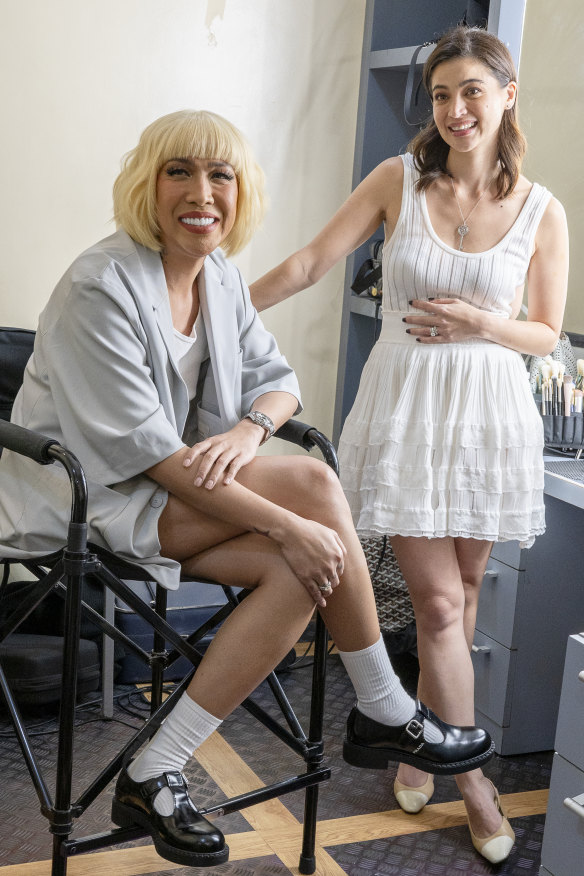
Curtis with her It’s Showtime co-host Vice Ganda, who calls her a “wonderful soul”.Credit: Dave Tacon
Anne Curtis’s co-host, Vice Ganda (Jose Marie Borja Viceral), is one of the country’s leading comedians. Ganda is non-binary (he doesn’t mind what pronoun is used). Recognition of a third gender is part of pre-colonial Philippines culture and gender blending is visible on the street, but the country is also conservative Catholic. Ganda says he is “accepted, but also not
accepted … if you are gay in this country you are tolerated as long as you are funny”.
His professional relationship with Curtis, “Asia’s sweetheart”, can only help. Curtis says Ganda is “making history” by being on It’s Showtime. “Maybe issues that weren’t tackled before now get thought about … Vice is very funny but to be that funny you have to be very smart, and he gets respect for that.” Ganda, meanwhile, says that Australians “should know that there is an Australian in the Philippines who is loved by the entire country … she’s just a wonderful soul.”
Noon is approaching. The warm-up artist is rousing the audience to a frenzy. Put aside your problems for the next few hours, he tells them. “It’s your time. It’s our time. It’s Showtime!” they chant. Then Curtis is among the audience, hugging, smiling, posing for selfies in the minutes before they go live. The crowd goes wild.
Yet there is a cloud. The following week, the show will be forced into a fortnight’s recess as punishment for a segment last July in which Ganda and his real-life partner and co-host, Ion Perez, licked birthday cake icing from their fingers (and Ganda from Perez’s fingers). The Philippines authorities cited “indecent acts”.
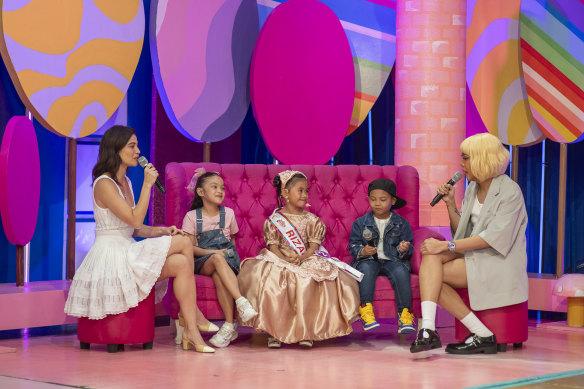
Curtis and Ganda (right), who is one of the country’s leading comedians, on camera.Credit: Dave Tacon
Talking with me, Curtis and Ganda mourn the impact of the suspension on the people employed in the studio. Most are casuals and will be out of work. In a country with little social security, that can mean hunger.
It is not the first time the show has been challenged by the authorities. In 2020, the administration of then president Rodrigo Duterte ordered ABS-CBN off the air in what international human rights groups described as a crushing blow to media freedom; the network is one of the country’s most important sources of news. It then lost a congressional vote to renew its licence.
It’s Showtime pivoted to streaming and digital distribution, and later to licence arrangements with other free-to-air channels. Extraordinarily, it retained most of its audience. For millions of ordinary people in the Philippines, the show is an anchor and an escape in their day. In a country with an estimated 18 per cent of the population in dire poverty, someone like Anne Curtis is important – a source of inspiration and aspiration.
I first heard the name Anne Curtis in 2015, when I was visiting Angeles City, a centre of the south-east Asian sex tourism industry a couple of hours’ drive north of Manila. I was researching a story about the abandoned children of Australian sex tourists.
In Angeles City, there is a cafe set up to resemble a 1950s country-town milk bar that sells Aussie burgers. There are pubs that stream AFL football and serve VB and XXXX on beer mats advertising DNA testing services – aimed at the men who are told they have fathered a child and want to be sure.
There’s even a sub-branch of the RSL with about 600 members. When I visited in 2015, the president was James Curtis-Smith, a then-73-year-old retired lawyer from Yarrawonga. He is Anne’s father. He happily agreed to be interviewed, turning up to my hotel up on a scooter in a bright green polo shirt with a boxing kangaroo on the pocket.
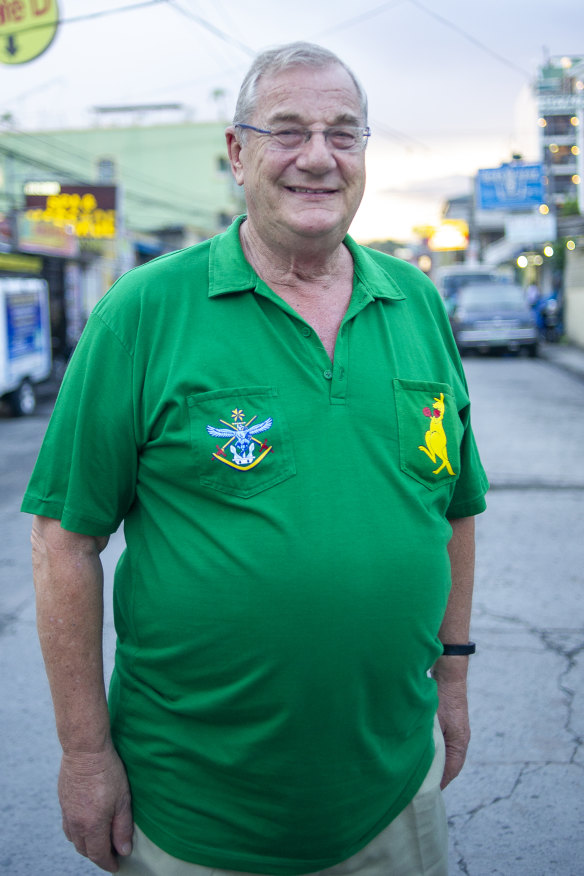
Anne’s dad James Curtis-Smith, who was with her when she was talent-spotted at age 12.Credit: Dave Tacon
Then and now, James Curtis-Smith is the enemy of woke. The attraction of the Philippines, he told me in 2015, apart from living well on the cheap, was that attitudes were “better”. You could compliment a woman without getting into trouble. He happily talked about the pattern in which older Western men, often widowers or divorcees in their 50s and 60s, ended up marrying the “entirely delightful” younger Filipino women. “The Filipina girl or woman is the most domestic type. They want a home, they want babies, they want to be homemakers and all these old guys love that,” he said.
He was an example of the pattern. He met Anne’s mother on a visit to Manila. “The waitress at the hotel I was staying at was particularly attractive, and one thing led to another,” he told me in that 2015 interview. At the end of our talk, he mentioned that his daughter Anne was “rather famous”. Online research that night alerted me to just how famous she was.
Curtis-Smith already had children with his first wife, an Australian. He would marry Carmencita Ojales, Anne’s mother, bringing her back to Yarrawonga, and father another three. That marriage ended, and he married another Filipino, adopting two of her children, and fathering another two, one of whom died in infancy. Today, Curtis-Smith lives with his most recent family in Angeles City.
The difference between Curtis-Smith and too many others was that he stood by his children – all of them – sending them to private schools and staying in their lives. In the context of Angeles City, he was a moral giant. He gave free legal help to women pursuing the fathers of their children for child support. Anne recalls that he’d call them at dinner time, knowing they would be with their families. It helped encourage quiet and quick settlement.
Anne was born in 1985. Her mother had opened a shop in Yarrawonga selling fried chicken. Her early memories are of “the best childhood imaginable”. She attended a Catholic primary school, learnt to ride her bike on dirt roads, went camping with the family on weekends and remembers rushing home on school days to watch Home and Away. “I suppose like most kids I dreamed that one day I may get a role in it.”
They returned to the Philippines at least once a year to visit family. When Anne was 12 and her father was preparing for retirement, they planned to relocate there. As they prepared for that move – checking out schools for Anne – they stopped at a Jollibee fast food outlet in metro Manila where Anne was spotted by a talent scout and offered work in advertisements.

Curtis in Magic Kingdom, the first of her 32 movies.
Her first screen role was in a Mitsubishi advert in which she was an angelic child buckling her belt in the backseat. Her first film role was Princess Dahlia in the 1997 fantasy cult classic Magic Kingdom. Erik Matti, then a junior student assistant in charge of auditions, remembers she stood out among the more than 100 children queuing up to try out for the role. “Her stance … was princess-like. And I was looking for a princess, so she was perfect.“
She got the role despite not speaking the Filipino language, Tagalog. Her voice had to be dubbed. After that, her career took off. She studied Tagalog intensively and took acting workshops. Acting, says Curtis, “triggered something in me … It is my passion.”
Curtis used to carry a portable mattress, so she could catch snatches of sleep on set.
The Filipino film industry works at a frantic pace. Until she became pregnant in 2019, Curtis made at least one movie each year, and usually two or three, as well as numerous television roles and, since 2009, It’s Showtime (she’s recorded more than 3800 episodes). Piñera recalls she used to carry a portable mattress, so she could catch snatches of sleep on set. Her sweet, “hardly ever grumpy” persona, Piñera says, hides a steely determination and dedication.
Most of Curtis’s roles have been lightweight romantic comedies. She has won numerous local acting awards, but not broken into the Western market. Through all this, Curtis avoided controversy, refusing requests to comment on politics. But, in 2017, she took a different tack.
Erik Matti was now head of his own production company and a fierce critic of the then Philippines president, Rodrigo Duterte, who had been elected in 2016 on a promise of tackling the country’s drug problem with a “war on drugs”. Matti approached Curtis’s agency, seeking stars for his latest project. Even the title – BuyBust – was provocative. It was the term used to describe operations in which police would go undercover to conduct a drug deal and arrest the dealers. Routinely, such operations ended with the accused shot dead. The standard explanation was “the suspect fought back”.
At the time Matti was recruiting, there were dozens of deaths each night. In all, according to the International Criminal Court prosecutor who is presently investigating the deaths, up to 30,000 citizens were killed. Perhaps not surprisingly, Matti had trouble finding a star for the film. Curtis’s agency told him nobody was available for a film that was, he recalls, “too dark, too full of action, too long, too expensive and perhaps too political”.

Curtis in slum-set thriller BuyBust, which carried a political message about the Filipino authorities’ brutal war on drugs.Credit: @annecurtissmith/Instagram
But four months later, he took a call. Anne Curtis was interested. She was bored with doing romances. In this movie, Matti warned Curtis, she would not be pretty. There would be no glamour and no laughs. Her face would be distorted with blood and bruises.
She poured herself into the role. She was the biggest star on the set but, says Matti, she “made mistakes, was interested in fixing the mistakes, and she was humble”. BuyBust was set in the country’s worst slums: Tondo in the Manila port district. The filmmakers were warned not to film there for fear of theft and violence, so their set recreated the neon-lit, labyrinthine hellhole. Curtis played rookie police officer Nina Manigan, who becomes the only survivor of her squad as her colleagues are slaughtered in a miasma of brutality, corruption and betrayal, surrounded by the fury of slum dwellers grieving their dead.
It was gruelling – filming overnight under cascades of rain. Curtis vomited multiple times on set. “Erik wanted a continuous shot,” she says. “I had to climb up a roof, do a fight scene, climb back down again, climb back up again and fall down.” She had studied parkour as part of rigorous physical and weapons training for the role. She was fit, but “I think we did 56 takes of that across two nights. It took me to the edge.” (Each morning, often without sleep, she would turn up – all smiles and energy – to co-host three hours of It’s Showtime.)
In the last scene of BuyBust, Curtis’s character realises that she is about to be killed, wrestles for a gun and shoots her colleague. Her last words are “The suspect fought back”, which in the context of the time was a powerful political statement. The camera pulls back into an overhead shot of the slum, showing roofs littered with corpses.
Curtis nominates BuyBust as the favourite of her movies, largely because of its political message. Human rights advocates in the Philippines frequently reference the movie. Yet, says Matti, neither he nor Curtis have paid a political price, nor does he think it has made a difference. It is a characteristic of the country, he says, that “people just carry on. They just turn a blind eye.”
In December 2019, Curtis and husband Heussaff flew to Australia for Dahlia’s birth. Curtis needed to retreat and to rest, which was only possible outside the Philippines – and she wanted the support of her mother. Curtis gave birth in early March 2020. She had planned to stay a few months more, but then the first COVID-19 lockdown hit. They were trapped in Melbourne.
An immense effort went into keeping her audience connected through social media. In one video, Heussaff attempted to placate his wife’s apparent craving for Jollibee by cooking her and her mother an imitation of that outlet’s trademark sweet spaghetti and Chickenjoy.
Meanwhile, the Philippines suffered one of the strictest and longest lockdowns in the world, and COVID spread like wildfire through the slums. Curtis’s homecoming was front-page news. On May 28, 2022, she returned to It’s Showtime: introduced by Ganda as “my sister” and revealed to the audience reclining and singing Ariana Grande’s Break Free. A few words in, she broke down with nerves, squealing in apparent panic. Undaunted, she did a second take, belting the lyrics out in her strange voice. This is the part where I’m stronger than I have ever been before, she sang. The audience loved it. Everybody cried.
At the last national elections in 2022, Curtis appeared at a campaign event for presidential candidate Leni Robredo, a long-time human rights lawyer and social activist who as vice-president under Duterte had been the effective leader of the opposition.
Curtis had posted to social media a picture of a rose that had been grown by her mother in Melbourne. It was, she said, called “a mother’s love” and was apt because Robredo would take care of the country like her own child. But in June 2022, Ferdinand “Bongbong” Marcos – son of dictator Ferdinand Marcos, who ruled the country between the 1960s and his overthrow in a 1986 popular rebellion, and aligned with Duterte – was elected with an overwhelming mandate.
Curtis says she doesn’t regret her advocacy. “At that point you could feel the energy, you could feel the want of every single person in the country wanting change.” So why did they vote for Marcos? “I don’t know. I was very, very hopeful alongside others. And now, I don’t want to speak about that any more because it’s actually very heartbreaking.“
It would be a mistake to cast Anne Curtis as an activist. She is cautious talking about politics. Doubtless some of the brands she endorses would prefer she did not. She rejects the suggestion that It’s Showtime’s recent trouble might have to do with her stance.
And yet, increasingly, Asia’s sweetheart stands for something. She is working with Matti on a sequel to BuyBust, as a television series contracted by a streaming platform. It will pick up on Curtis’s character five years later in, as Matti puts it, “a dystopian world of the Philippines, now on the road to becoming a First World country. The pressure is on for the government to discipline the whole country so that we can compete with the likes of Singapore, Japan, Korea.” Pre-production has started and Curtis is training with weapons and knives.
But Curtis has no plans to leave It’s Showtime anytime soon. The audience keeps her there. She loves the connection, hearing their stories, watching the show’s cash prizes change lives. Before her daughter Dahlia’s birth, she said that if she had children, she would want to raise them in Australia. That has changed.
She visits Melbourne at least twice a year, but the Philippines is home. And she has promised her audience that she will not leave them again.
To read more from Good Weekend magazine, visit our page at The Sydney Morning Herald, The Age and Brisbane Times.